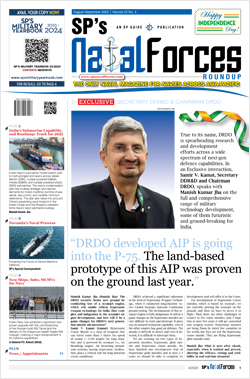INDIAN ARMED FORCES CHIEFS ON OUR RELENTLESS AND FOCUSED PUBLISHING EFFORTS

The insightful articles, inspiring narrations and analytical perspectives presented by the Editorial Team, establish an alluring connect with the reader. My compliments and best wishes to SP Guide Publications.

"Over the past 60 years, the growth of SP Guide Publications has mirrored the rising stature of Indian Navy. Its well-researched and informative magazines on Defence and Aerospace sector have served to shape an educated opinion of our military personnel, policy makers and the public alike. I wish SP's Publication team continued success, fair winds and following seas in all future endeavour!"

Since, its inception in 1964, SP Guide Publications has consistently demonstrated commitment to high-quality journalism in the aerospace and defence sectors, earning a well-deserved reputation as Asia's largest media house in this domain. I wish SP Guide Publications continued success in its pursuit of excellence.
News
US Navy Plans to Deploy Cost-Saving Laser Technology
Citing a series of technological breakthroughs, the US Navy has on April 8, 2013, announced plans at the sea-air-space exposition to deploy for the first time a solid-state laser aboard a ship in the fiscal year 2014. “Our directed energy initiatives and specifically the solid-state laser, are among our highest priority science and technology programmes. The solid-state laser programme is central to our commitment to quickly deliver advanced capabilities to forward-deployed forces,” said Chief of Naval Research Rear Admiral Matthew Klunder. “This capability provides a tremendously affordable answer to the costly problem of defending against asymmetric threats, and that kind of innovative approach is crucial in a fiscally-constrained environment.”The announcement to deploy the laser onboards USS Ponce comes as navy researchers continue to make significant progress on directed energy weapons, allowing the service to deploy a laser weapon on a navy ship, two years ahead of schedule. The at-sea demonstration in fiscal year 2014 is part of a wider portfolio of near-term Navy directed energy programmes that promise rapid fielding, demonstration and prototyping efforts for shipboard, airborne and ground systems.
“Our conservative data tells us a shot of directed energy costs under $1,” Klunder said. “Compare that to the hundreds of thousands of dollars it costs to fire a missile and you can begin to see the merits of this capability.” The Office of Naval Research (ONR) and Naval Sea Systems Command recently performed demonstrations of high-energy lasers aboard a moving surface combatant ship, as well as against remotely-piloted aircraft. Through careful planning of such demonstrations and by leveraging investments made through other Department of Defense (DoD) agencies, researchers have been able to increase the ruggedness, power and beam quality of lasers, more than doubling the range of weapons. “The future is here,” said Peter A. Morrision, Program Officer for ONR’s solid-state laser technology maturation programme. “The solid-state laser is a big step forward towards revolutionising modern warfare with directed energy; just as the gunpowder did in the era of knives and swords.”
Officials consider the solid-state laser a revolutionary technology that gives the navy an extremely affordable, multi-mission weapon with a deep magazine and unmatched precision, targeting and control functions. Because lasers run on electricity, they can be fired as long as there is power and provide a measure of safety as they don’t require carrying propellants and explosives aboard ships. Lasers complement kinetic weapons to create a layered ship defence capability, providing improved protection against swarming small boats and unmanned aircraft at a fraction of the cost of traditional weapons. The advancing technology gives sailors a variety of options they never had before, including the ability to control a laser weapon’s output and perform actions ranging from non-lethal disabling and deterrence all the way up to destruction.
“We expect that in the future, a missile will not be able to simply outmanoeuvre a highly accurate, high-energy laser beam, travelling at the speed of light,” said Klunder. Following the USS Ponce demonstration, the US Navy and DoD will continue to research ways to integrate affordable laser weapons into the fleet.





